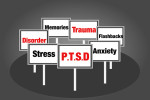

Post-Traumatic Stress Disorder and How It May Be Affecting You
Karen is a happ y-go lucky 65-year old retiree. She spends her time volunteering and working in her garden. One day, a good friend of hers picks her up to drive to church. On the way there, a semi-truck loses control and crashes into their car, killing Karen’s friend instantly. Karen survives, suffering only a few broken ribs, and bruising.
y-go lucky 65-year old retiree. She spends her time volunteering and working in her garden. One day, a good friend of hers picks her up to drive to church. On the way there, a semi-truck loses control and crashes into their car, killing Karen’s friend instantly. Karen survives, suffering only a few broken ribs, and bruising.
Since the accident, Karen keeps having flashbacks, which cause her to lose sense of time. These flashbacks frighten her, and she has a hard time doing anything that reminds her of the accident. This includes going to church, riding in cars, or anything that reminds her of the friend she lost. She loses interest in things, and begins to drink heavily in order to deal with the anxiety she feels. Eventually, her family persuades her to go see a therapist, who diagnoses her with PTSD.
Post-traumatic Stress Syndrome (PTSD) is an anxiety disorder that develops after someone is exposed to a traumatic event. This can include serious injury, sexual or physical assault, or any sort of life-threatening event such as natural disasters or near-death encounters among many others.
It’s normal to feel an array of intense emotions after experiencing something traumatic, but if these feelings last for more than a month, it could indicate that a person may be suffering from PTSD.
When we are faced with a dangerous situation, it arouses fear within us, which in turn causes our body to produce adrenaline. This adrenaline keeps us highly alert and defensive, in order to help us avoid or defend ourselves against whatever danger we may be faced with. PTSD causes a change in our body, which makes it so that we continue to be on high-alert mode long after whatever dangerous situation we may have been in has subsided. This causes us to experience symptoms of PTSD.
These symptoms can be categorized into three groups: re-experiencing symptoms, avoidance symptoms and hyper-arousal symptoms.
Re-Experiencing Symptoms
These types of symptoms can be triggered by almost anything that reminds a person of their traumatic event. The trigger doesn’t have to be external, even a person’s thoughts or feelings can cause them to relive the trauma over and over.
Avoidance Symptoms
A person with PTSD may change their routine in order to avoid places, events, or objects that remind him/her of the traumatic event. Often, PTSD will cause someone to have trouble remembering the traumatic experience. Many report feeling as though they are numb, and more often than not PTSD will trigger heavy bouts of depression.
Hyper-arousal Symptoms
These symptoms are the most constant, and someone with PTSD will consistently feel tense or on edge. These symptoms will make it hard for someone to do basic things such as eating or sleeping.
Once you enter the second half of your life, the chances of you developing PTSD as a reaction to a traumatic event increase exponentially. Sometimes a traumatic event that happened earlier in your life could resurface and causing late-onset PTSD symptoms.
Many who grew up prior to the late 1970s, may have had PTSD but never been diagnosed with it. This rings true especially with war vets. A study done on PTSD in WWII veterans showed that symptoms might be attributed to current issues and the aging process, and not old traumas. Although intrusive symptoms faded with time, avoidance symptoms and estrangement symptoms increased, as the men got older.
The problem with late-onset PTSD is that it is often misdiagnosed in older adults as a different medical problem because older adults are more prone to focus on physical symptoms rather than the underlying emotional ones.
Often some sort of significant life change will trigger this delayed-onset of symptoms during the previous year, such as loss of employment or separation/loss of family. Retirement is the most widely reported event that seems to cause late-onset PTSD. Without having something like work or raising a family to focus on, many have more time to reflect on events (including traumatic ones) that occurred earlier in life.
The good news is that there are a variety of ways you can go about treating yourself, including trauma-focused cognitive behavioral therapy, family therapy, medication, GLT Pure Awareness Techniques, and EMDR. If you think you may have PTSD, click here to find out how to get help.
Author: Kimberly Recor, staff writer at Designing Brighter Tomorrows
© 2014 Designing Brighter Tomorrows, Inc.
This site is for information only, and is for your voluntary use at your own risk. See Terms of Use